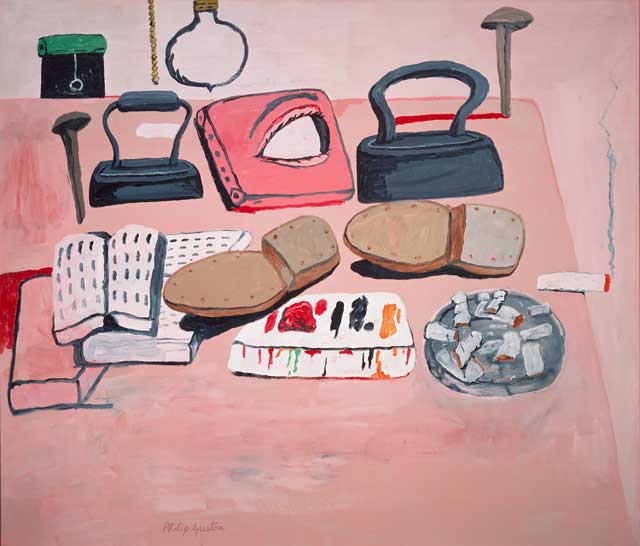Great Works: Painter's Table (1973), Philip Guston
National Gallery of Art, Washington

Pinkstinks: that is the name and the slogan of a campaign, launched last year, opposing the dominance of pink in the lives of little girls. The campaigners observed that it is hard to buy girls clothes or toys that are not in some shade of rose, peach or fuchsia. And this uniform, they argued, offers girls the most self-undermining ideals: a girly, sugary, pretty-pretty, passive, flirty image which prepares them for a life of hairdressing and lapdancing.
The voice of common sense retorted, of course, and what it said was that this colour was not being imposed. Little girls love pink. For a while they play at fairies and princesses. It is a phase. They go through it and onwards to become scientists and commandos. But both sides in this dispute seemed to agree on one point. Pink does mean something. It means girliness.
Colours do have values; it's good to have this acknowledged. They are rich in associations. They are symbolic. They carry feelings. But their stories are seldom straightforward. Pink, for instance, is the colour of the Breast Cancer Campaign's awareness ribbon – pink meaning female, and also evoking flesh. The pink triangle is now the badge of gay pride. This is the inversion of its original usage, in Nazi concentration camps, where it was the badge worn by homosexuals and other sexual offenders. The Nazi colour choice was perhaps arbitrary. Perhaps again there was an implication of flesh.
That pink, at any rate, wasn't making an equation of gay and girlish. Pink wasn't assigned to girls until the mid-20th-century. Nor, today, is a powerful man who wears a bold pink shirt considered girly. He's flamboyant. On the other hand, as Diana Vreeland said: "Pink is the navy blue of India" – it is not flamboyant there at all.
In Christianity, deep blue is the colour of the Virgin Mary, while the Great Whore of Revelation is "arrayed in purple and scarlet colour": both female, neither girly. But the pinks of contemporary little girlhood are, arguably, sexualising. Like lipstick? It's a complicated area.
The great modern pink-painter is Philip Guston. In his earlier abstractions it is the dominant hue. In his later heavy figuration it becomes pressing. It is a rare colour agenda in painting anywhere. And if you thought pink must be sweet – even Picasso's "Pink Period", so dreamy and melancholic, comes up smelling of roses – think again.
Take Painter's Table, a Guston still life. It's not exactly a pretty sight, but semi-comic: nails, shoes, flat irons, books, stubbed butts, a canvas with a gaping eyeball, a palette, a smouldering dogend, laid out individually. There are four main pinks: in the background; two on the table top; a very strong one on the canvas. Almost everything else is not pink.
Some Gustons are full of pink body parts, bulging, piggy flesh, with their outlines and shadows done in blood red. Painter's Table isn't literally meaty like that. But see how it is shaped and painted: saggy, lumpish, clumpy, sluggish, slobbish, squidgy.
This scene has a strong physical sensibility, in other words, and this gets into the pinks too. They may be, optically speaking, the pinks you find in the girly wardrobe. But they don't feel like candyfloss or even lipstick. Colour never lives by itself. And in this setting, in this viscous brushwork, these pinks release quite different associations.
They become slobbish, squidgy pinks; if sweet at all, sickly sweet. Far from fairies and princesses, roses and fuchsias, these are the pinks of Germolene, sticking plaster, bubblegum, prawn cocktail, pork paté and sausage meat. Guston makes us face facts. Some pinks really do stink.
About the artist
Philip Guston (1913-80) was a New York painter who changed course twice. He started figurative, surreal-satirical. After the war he joined the abstraction gang, with a manner sometimes called Abstract Impressionism. Around 1970, cartoonish shapes began to coalesce. What emerged was the most vigorous late-20th-century figurative style: a vocabulary of gross body parts, eyeballs, hairy bollocks, fag ends, hobnail boots, dustbin lids, piled up, painted raw, thick, fatty, wrecked; hang-over pictures, heart-attack pictures, a savage farce with a delicate wit.
Subscribe to Independent Premium to bookmark this article
Want to bookmark your favourite articles and stories to read or reference later? Start your Independent Premium subscription today.

Join our commenting forum
Join thought-provoking conversations, follow other Independent readers and see their replies